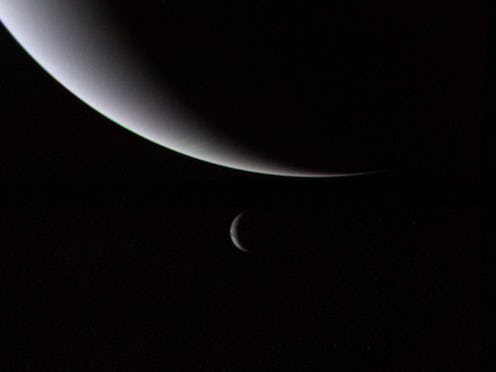
In case you missed it, there’s a mysterious object behind Neptune right now, and no one really knows what it is. Researchers are calling it Niku — but besides its size and the fact that it’s traveling… oddly, there’s really not much else we can say about it. So how big is Niku, exactly? Well, the short version is that Niku’s diameter is estimated at about 124 miles — but what does that mean? Let’s explore. Because the universe is a strange place, and it just got a whole lot stranger.
Researchers discovered the trans-Neptunian object, or TNO, fairly recently; a paper submitted to arXiv on Aug. 5, 2016 details its detection by the Pan-STARRS 1 Outer Solar System Survey and subsequent nicknaming as “Niku." There’s a lot that’s weird about Niku, but the weirdest thing is how it’s behaving: It’s orbiting the opposite way that most other orbits travel in our solar system. That’s why it’s called Niku; it's derived from the word for “rebellious" in Chinese. And what’s more, scientists can’t explain exactly why it’s orbiting that way yet — each theory has gotten shot down, deemed problematic based on what we know about the solar system.
As astronomer Michele Bannister put it on Twitter:
Which brings us back to the initial question: How big is Niku? Well, unless you’re really good with numbers in general and distances specifically, 124 miles in diameter might not mean much to you. (Welcome to my world. It’s a fun place. Most of the time.) So for the curious, here are a few things that are roughly the same size or distance as Niku’s diameter (if, that is, I did the math right. I'm pretty sure I did, but sometimes weird things happen when non-math people try to do math):
1. The Distance Between Annapolis, Md. And Philadelphia, Pa.
If you take I-95 the whole way, it’s about 128 miles, which will take you around two hours to drive if there’s no traffic. The distance stretches a little bit if you go via US-1 and I-95, but not by much; in that case, it’s about 137 miles.
2. A Crater Left By The Asteroid That Killed The Dinosaurs
The crater is called Chicxulub, and it’s located off the coast of Mexico. About 125 miles across, it’s the result of an asteroid roughly the size of Staten Island crashed into the planet 66 million years ago. Earlier this year, researchers drilling from an offshore platform found rocks left over from the day the asteroid landed.
3. 1,047,552 Unsharpened Pencils Laid End To End
An unsharpened number two pencil is about 7.5 inches long. There are 63,360 inches in a mile, which means 8,448 pencils laid end to end will equal about a mile. Multiply that by 124, and you have the number of unsharpened pencils that stretch the diameter of Niku.
4. Almost 4,000 Olympic Swimming Pool Lengths
A long course Olympic swimming pool is about 164 feet long. There are 5,280 feet in a mile, so there are about 32 pool lengths in the aforementioned mile. Multiply that by 124, and you get just shy of 4,000 Olympic pool lengths total (3,968 if we round the numbers, 3,992 if we don't). No word on what happens when you unleash Katie Ledecky on that many pools.
5. The Distance Spanish YouTuber SoninGame Has Walked While Playing “Pokemon Go”
She’s probably walked substantially more than that now; 124 miles was her count when Broadly interviewed her on July 18. For whatever that’s worth.
6. The Speed At Which This Human Catapult Travels
Apparently it goes from zero to 125 miles per hour in one second. Also, did I mention that it’s a human catapult? You heard me: It fires people. For reals.
I think I’m going to take a hard pass on that one.
7. About 18 Times As Deep As The Ocean
At its deepest point — the Marianas Trench in the Pacific Ocean—the sea goes down 6.8 miles. Niku is about 18 times that.
8. 94,658 Snorlaxes
A Snorlax is apparently about 6’11”, which means there are 763 Snorlaxes in a mile, which means there are 94,658 Snorlaxes in 124 miles. That’s assuming they’re all laid out on the ground, although I suppose you could also try to stack them on each other’s shoulders. No promises the Stack O’ Snorlaxes will be able to stay standing, though.
Images: Wikimedia Commons; Giphy (8)